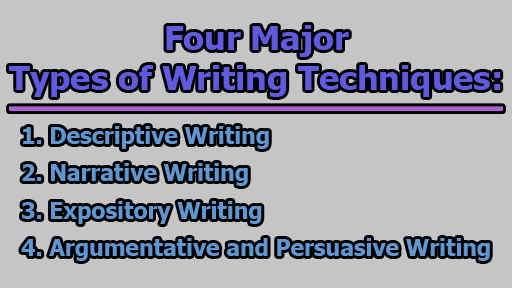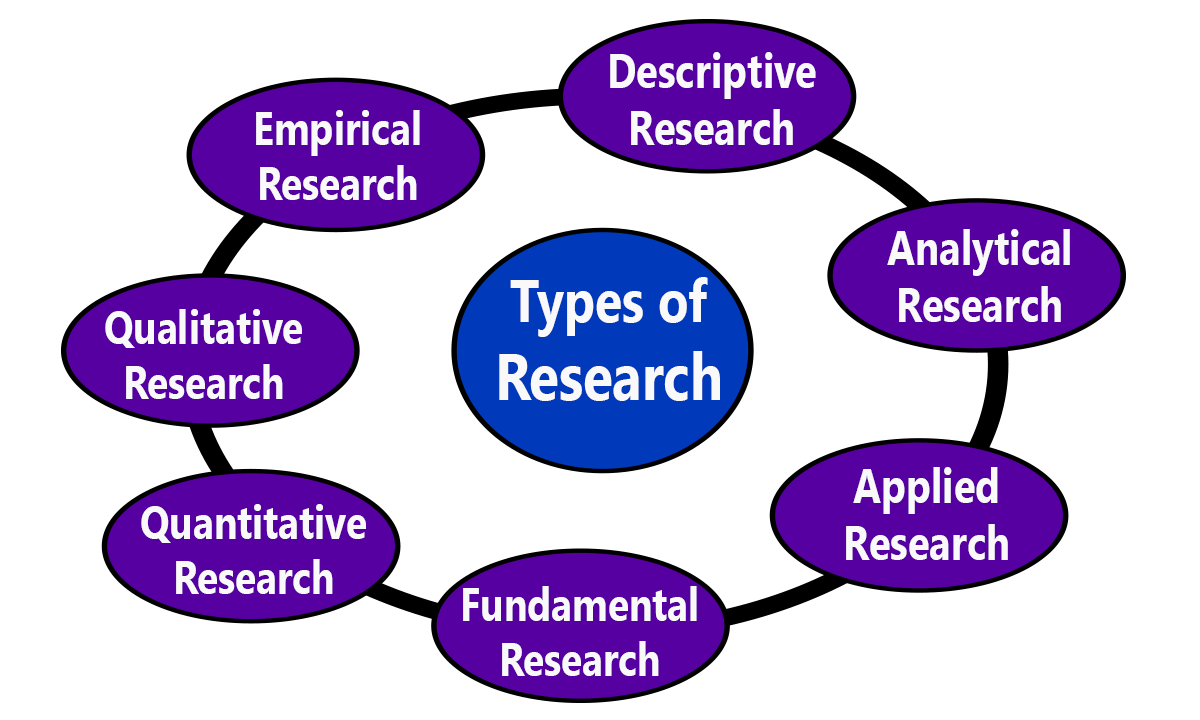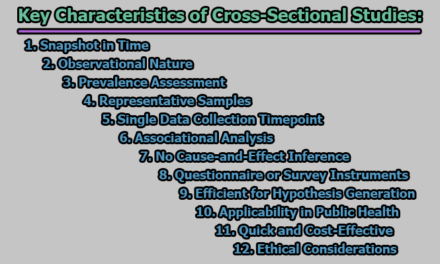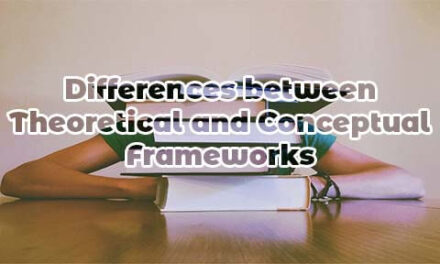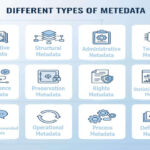Writing is an art form that goes beyond mere words on a page; it is a craft that involves the skillful use of various writing techniques to convey thoughts, ideas, and emotions effectively. Whether you are an aspiring writer, a student, or a professional, understanding writing techniques is crucial for honing your communication skills and creating impactful content. In this article, we will delve into the importance and four major types of writing techniques: descriptive, narrative, expository, and argumentative/persuasive writing.
What are Writing Techniques?
Writing Techniques refer to the various methods, styles, and approaches employed by writers to convey information, ideas, or emotions effectively. These techniques encompass a range of literary devices, structural elements, and rhetorical strategies used to enhance the clarity, impact, and engagement of written communication. Mastering writing techniques is essential for crafting diverse genres, meeting specific writing purposes, and appealing to varied audiences.
Why You Must Learn About Writing Techniques?
Learning about writing techniques is essential for various reasons, transcending the realms of academia, professional life, and personal development. Here are brief explanations of why individuals must invest time and effort in acquiring a comprehensive understanding of writing techniques:
- Enhanced Communication Skills:
- Clarity and Precision: Writing techniques provide a toolkit for expressing thoughts and ideas with clarity and precision. Effective communication hinges on the ability to convey messages in a manner that is easily understood by the audience.
- Articulation of Complex Ideas: In professional and academic settings, individuals often need to communicate complex concepts. Writing techniques empower writers to articulate intricate ideas in a coherent and accessible manner.
- Versatility in Expression:
- Adaptability to Different Genres: Different forms of writing demand distinct approaches. A versatile writer who has mastered various techniques can adapt their style to suit genres such as academic papers, creative works, business documents, and more.
- Situational Appropriateness: Being familiar with diverse writing techniques enables writers to choose the most suitable approach for a given context, ensuring their message aligns with the purpose and audience.
- Creativity and Artistic Expression:
- Engaging the Imagination: Writing techniques are essential tools for writers to engage the imagination of their readers. Techniques such as vivid descriptions, metaphors, and symbolism allow for the creation of immersive and emotionally resonant narratives.
- Personal Expression: For creative writers, understanding techniques like narrative structure, character development, and dialogue enhances their ability to express unique perspectives, emotions, and experiences.
- Meeting Diverse Writing Purposes:
- Information Dissemination: Learning writing techniques is crucial for crafting informative and educational content. Expository writing, for example, is adept at presenting facts and explanations in a clear and organized manner.
- Persuasion and Advocacy: In both professional and personal spheres, the ability to persuade others is valuable. Mastery of argumentative and persuasive writing techniques equips individuals to effectively convey opinions, influence decisions, and advocate for specific actions.
- Building Credibility and Authority:
- Professionalism: A writer who can navigate various writing techniques exhibits a higher level of professionalism. This skill is particularly important in academic and business settings, where clear, well-structured writing contributes to one’s credibility and authority.
- Expertise Demonstration: Using advanced writing techniques showcases a writer’s expertise in their field. Whether drafting research papers, reports, or opinion pieces, employing appropriate techniques reinforces the author’s command over the subject matter.
- Personal and Professional Growth:
- Critical Thinking: Learning writing techniques fosters critical thinking skills. Writers must make intentional choices about language, structure, and style, encouraging a thoughtful approach to conveying ideas.
- Lifelong Learning: Writing is a skill that evolves over time. Continual exploration and application of writing techniques contribute to ongoing personal and professional growth, enabling individuals to refine their craft and stay relevant in dynamic environments.
Importance of Different Writing Techniques:
Different writing techniques are essential due to their role in facilitating effective communication across diverse genres, purposes, and audiences. The adoption of specific techniques caters to the nuances of various writing scenarios, ensuring that the message is not only conveyed but also comprehended and appreciated. Here are in depth explanations highlighting the essential nature of different writing techniques:
- Catering to Varied Audiences:
- Tailoring the Message: Different audiences possess varying levels of familiarity with a subject, preferences, and expectations. Employing the appropriate writing technique allows the writer to tailor the message to suit the specific needs and understanding of the intended audience.
- Engagement and Connection: By understanding the demographics, interests, and knowledge levels of their audience, writers can choose techniques that foster engagement and create a connection. This is crucial for capturing and maintaining the reader’s attention.
- Meeting Diverse Writing Purposes:
- Information vs. Persuasion: Writing serves multifaceted purposes, ranging from informative to persuasive. Techniques like expository writing excel in presenting information objectively, while argumentative or persuasive writing techniques are designed to sway opinions and prompt action.
- Educational Materials: In academic and instructional settings, different techniques are employed based on the educational objectives. For instance, descriptive writing may be used to vividly illustrate concepts, while expository writing is effective for conveying factual information.
- Building Credibility and Authority:
- Expertise in Versatility: A writer who can adeptly employ various writing techniques showcases a high level of expertise and versatility. This versatility contributes to building credibility and authority, as it demonstrates the writer’s ability to navigate different communication challenges.
- Professionalism: In professional contexts, the judicious use of writing techniques enhances the professionalism of written communication. Whether it’s a business proposal, a technical report, or a marketing copy, the right technique reinforces the writer’s competence.
- Expressive Range and Creativity:
- Immersive Descriptions: Descriptive writing techniques allow for the creation of rich, immersive environments by appealing to the senses. This enhances the reader’s experience and adds depth to narratives, fostering a more creative and evocative style.
- Storytelling Capabilities: Narrative techniques are essential for storytelling, enabling writers to construct compelling narratives with engaging plots, well-developed characters, and meaningful arcs. This not only captures the reader’s interest but also allows for the effective conveyance of messages through storytelling.
- Adapting to Different Genres:
- Academic Writing: Academic writing often necessitates expository techniques for clarity and precision. The emphasis is on presenting research, analysis, and findings in an organized and systematic manner.
- Fiction and Creative Writing: Creative writing, including fiction and poetry, relies on descriptive and narrative techniques to evoke emotions, create atmospheres, and captivate readers. The emphasis here is on imagination, storytelling, and the artistic use of language.
- Facilitating Effective Persuasion:
- Rhetorical Strategies: Argumentative and persuasive writing techniques employ rhetorical strategies, emotional appeals, and logical reasoning to convince and persuade the reader. These techniques are particularly crucial in opinion pieces, marketing materials, and persuasive essays.
- Call to Action: Persuasive writing often concludes with a call to action, urging the reader to adopt a particular viewpoint, make a decision, or take specific steps. The effectiveness of this call to action is closely tied to the persuasive techniques employed throughout the text.
Four Major Types of Writing Techniques:
The world of writing is a vast landscape, and mastering various writing techniques is crucial for writers to effectively convey their messages. Here, we explain four major writing techniques, exploring their characteristics, applications, and significance in different contexts:
- Descriptive Writing:
- Characteristics: Descriptive writing is an art form that focuses on painting vivid images in the reader’s mind by appealing to the senses. It employs detailed language, sensory imagery, and vivid metaphors to create a rich and immersive experience for the audience.
- Applications: Descriptive writing is commonly found in creative works such as fiction, poetry, and creative non-fiction. It is instrumental in establishing atmospheric settings, evoking emotions, and providing readers with a sensory journey.
- Significance: This technique adds depth and texture to narratives, making them more engaging and memorable. Descriptive writing allows writers to craft environments that resonate with readers, fostering a deeper connection between the audience and the content.
- Example: The sun dipped below the horizon, casting a warm, golden glow across the rolling hills. The air carried the sweet scent of wildflowers, and a gentle breeze whispered through the tall grass, creating a symphony of nature’s melodies.
- Narrative Writing:
- Characteristics: Narrative writing is centered around storytelling, involving the presentation of events in a structured and cohesive manner. It typically includes elements such as characters, settings, conflicts, and resolutions, unfolding a plot with a clear beginning, middle, and end.
- Applications: Narrative writing is prevalent in fiction, novels, short stories, and also extends to non-fiction genres such as memoirs and personal essays. It enables writers to communicate experiences, share perspectives, and engage readers through a compelling narrative arc.
- Significance: Narrative writing captivates audiences by fostering a sense of connection and empathy. It allows readers to immerse themselves in the story, creating a memorable and impactful reading experience.
- Example: As the old wooden door creaked open, Sarah stepped into the dimly lit room. The dusty furniture whispered tales of bygone days, and a faded photograph on the wall hinted at a love story that had weathered the passage of time.
- Expository Writing:
- Characteristics: Expository writing is characterized by its informative and objective nature. It aims to convey information, explain concepts, or clarify ideas in a clear and concise manner. This technique emphasizes logical organization, factual presentation, and a straightforward writing style.
- Applications: Expository writing is commonly employed in academic settings for research papers, essays, and technical reports. It is also prevalent in non-fiction genres such as journalism, explanatory articles, and instructional manuals.
- Significance: The primary purpose of expository writing is to provide information in a manner that is easily understood. It is essential for conveying complex ideas to diverse audiences and is valued for its clarity and accessibility.
- Example: The process of photosynthesis can be explained as the conversion of sunlight into chemical energy by plants. During this intricate biochemical process, carbon dioxide and water are transformed into glucose and oxygen, providing energy for the plant and releasing oxygen into the atmosphere.
- Argumentative and Persuasive Writing:
- Characteristics: Argumentative and persuasive writing aim to convince the audience of a particular viewpoint or persuade them to take specific actions. While both share the goal of influencing the reader, argumentative writing presents a balanced examination of a topic, while persuasive writing relies on emotional appeal and a more assertive tone.
- Applications: These techniques are often employed in opinion pieces, editorials, advertising, and political speeches. They are crucial for presenting a compelling case, promoting a product, or advocating for a particular stance.
- Significance: Argumentative and persuasive writing techniques are powerful tools for influencing opinions and inspiring action. They require a mastery of rhetorical devices, logical reasoning, and a keen understanding of the audience’s mindset.
- Example (Argumentative): While proponents of renewable energy argue for its environmental benefits, opponents contend that the initial costs and intermittency issues make it an impractical solution for widespread energy use.
- Example (Persuasive): Join the movement for sustainable living! By making small changes in our daily habits, such as reducing single-use plastic and conserving energy, we can collectively create a healthier planet for future generations.
In conclusion, mastering writing techniques is a journey that opens up a world of possibilities for effective communication, creative expression, and professional success. Whether you aspire to become a novelist, a journalist, an academic, or a business professional, understanding and harnessing different writing techniques will set you apart and elevate your writing to new heights. So, embark on this journey, explore the nuances of descriptive, narrative, expository, and argumentative/persuasive writing, and unlock the full potential of your writing prowess.

Library Lecturer at Nurul Amin Degree College

